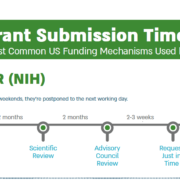AN INTRO TO SBIR
Part I: What are SBIRs/STTRs?
The total pocket of non-dilutive funding from the US government is around $50B annually. Most of the non-dilutive funding for life sciences, biotech and medtech comes from the National Institutes of Health (NIH) – around $28B in 2018 (against a total budget of $37B). Through the 24 funding institutes at the NIH, numerous indications can be funded. So, no matter your field, the NIH can potentially fund your project.
One mechanism for non-dilutive funding from the NIH is SBIR (small business innovation research)/STTR (small business technology transfer). These are congressionally-mandated programs – money must be set aside each year – whose goal is to strengthen the role of innovative small businesses in federally funded R&D: “support scientific excellence and technological innovation through the investment of federal research funds in critical American priorities to build a strong national economy.”
Any institute with an extramural R&D budget over $100M must allocate 3.2% of that budget for SBIR and institutes with an extramural R&D budget over $1B must allocate for 0.45% for STTR each year. SBIR is available for domestic (US-based) small business concerns (SBCs). While the goal is to help small business engage in R&D – the NIH specifically looks for those with potential for commercialization.
Look for An Intro to SBIR/STTR Part II next week!












Leave a Reply
Want to join the discussion?Feel free to contribute!